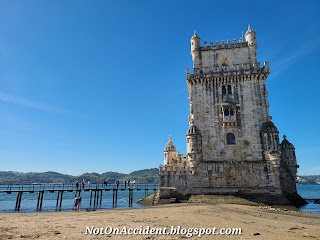Thursday was a tour of a few of the surrounding towns, with our first stop in the medieval town of Óbidos (pronounced 'o-bee-dosh' by Nélia). They formerly used windmills in this area to grind grain, so they are somewhat a symbol of the region, however, they must not sell well because they weren't to be found, in replica form, in most of the shops I visited. I've been searching, since Porto, for a pair of dangly earrings shaped like tiny azulejos. Unfortunately, it has been in vain thus far; every shop I've perused (in lightning fashion) has only a poor imitation of the tiles: a glazed dome over the tile pattern, partially obscuring the pattern so you'd never imagine it to be a tile from Portugal.
Anyway, the town has been well restored, so the exterior of the homes there still appear as they may have in the 1500's, and the city wall is still incredibly well intact. It was considered one of the Queen's towns for hundreds of years, so their taxes all went to her, and not to the King. As such, many of the Óbidos festivals reflect that heritage. Understandably, they have a huge Medieval festival each year (even the Portuguese attend), and they have a large chocolate festival. In this area they sell and, I assume, make Ginja, a sour-cherry liquor which they serve in chocolate cups. I popped my head into a few churches, but there was no real "tour" so we were free to wander. I struck out for the walls of the city to catch the views of the surrounding landscape (while quickly checking the numerous shops for the aforementioned earrings).
Back on the bus we headed north to the city of Alcobaça (pronounced Al-koo-baas-sa) to visit their monestary, also known as Santa Maria de Alcobaça Church. It's the first building in the country to be fully built in the Gothic style. in addition, it's the largest church Portugal, with over 100 meters from the door to the alter. Despite the Gothic inside, the exterior façade is in the Baroque style.
Construction was begun in 1178 by Cistercian monks and the church was consecrated in 1252. The other interesting aspect of the church is who was entombed there: King Pedro I and his lover, Inês de Castro. The story, as told by Nélia and what I've read online have similar narrations, but the exact timeline is still fuzzy for me. Either way, he was madly in love with her, claimed they had been married in secret (all before he was actually king), but his father, King Afonso, had her killed to prevent her family from influencing politics in Portugal and from becoming royalty (by extension) - the usual reasons for that time period, I guess. Their sarcophaguses were incredibly ornate. Sadly, many of the statues carved into them are now headless because of Napoleon's troops.
They believed that the Portuguese buried their kings with jewels (they don't, even though they had incredible wealth), so when the troops found none inside the sarcophaguses they thought the monks had been clever and hidden the jewels inside the statues carved into the outside (wrong again). The monastery was extensive and in it's heyday had at least 1,000 monks. Although it was a bit austere, it was a beautiful church, though enjoyed mainly by the monks. Since they didn't allow common-folk inside until the 18th century, that could explain its plain interior.
From there we headed east to Nazaré which was once known for their small, beautiful fishing boats used in the dangerous waters (there is a bad undertow).

The women dry the catch out in the sun on the beach to preserve it for times when the men can't go out and fish.
They still do some fishing today, not now the area is known for surfing -- especially the colossal waves out around the point that are stories-high. The area by the beach is extremely touristy, but one or two streets in it all appeared very residential -- no shops, just laundry drying in the warm spring wind.
We got back on the bus for the hour-and-a-half ride back to Lisbon and then had about an hour before our farewell drink and dinner. Because of the seat rotations on the bus I didn't get a chance to properly meet everyone on the tour, and within a few days most people stop wearing their name tags, so if you didn't catch a name by day 2 or 3 you'll have to ask. Anyway, I finally met a couple from Ohio that it turns out used to vacation in Australia quite frequently 30 years ago. Port Douglas and Palm Cove...lovely memories of those places, so it was almost as good as meeting someone from Western PA. We did get a group photo before heading to dinner, so that was a really nice memento. Dinner was tasty, but it was stifling hot in the restaurant that night. I bookended my trip with the Boston crew, rounding out their numbers for one final time. Oddly enough, it was the first time I could have sat elsewhere (there weren't exactly 42 seats saved), but my welcome dinner and every group dinner after had been with them, so it was only fitting. Overall, we had such a lovely crew that I can honestly say I could have spent another week with them all. Who knows, maybe we'll bump into each other on another Gate1 tour someday.






















































